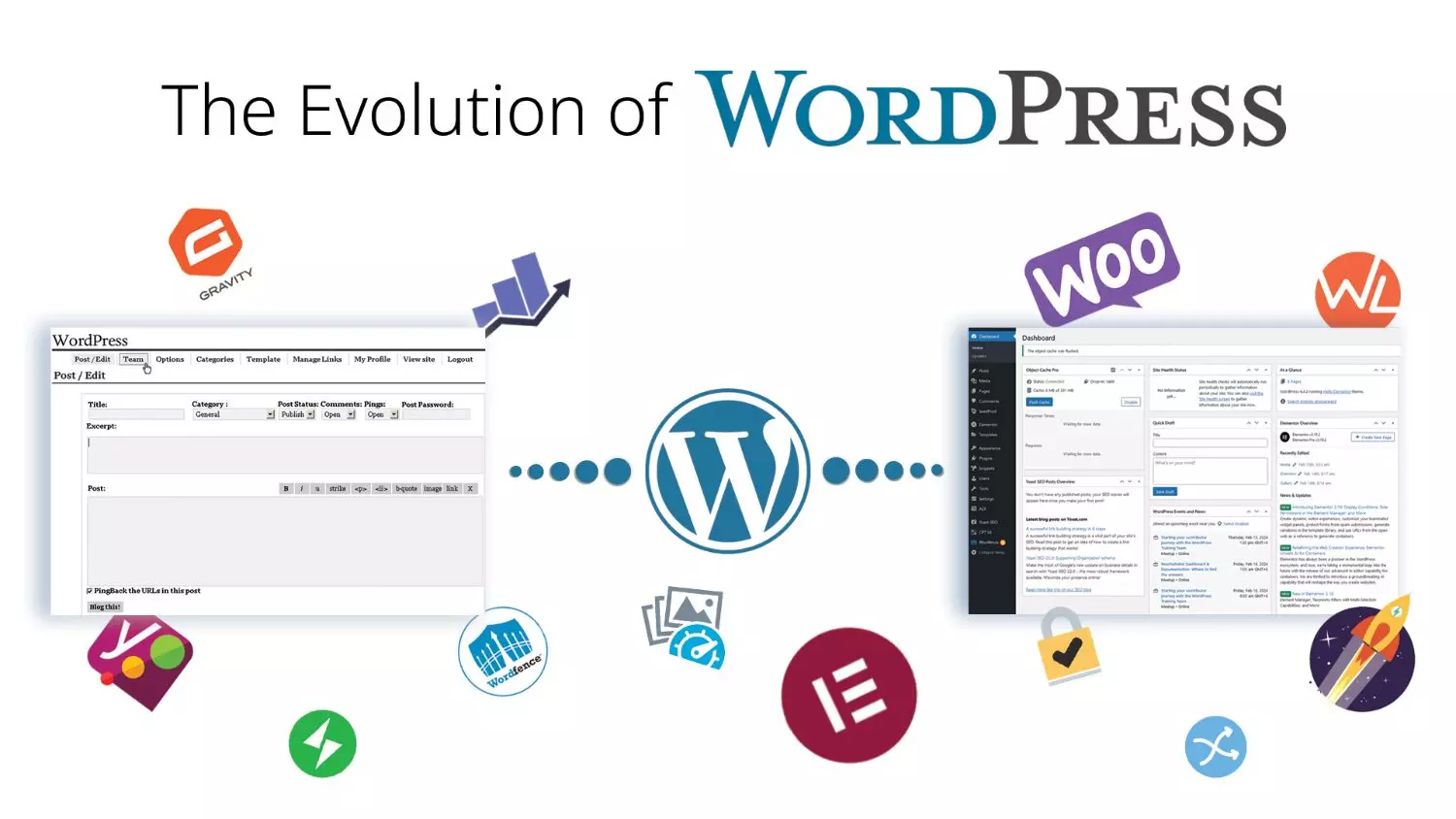- Blog
The Evolution of WordPress

WordPress is a complete magic package for bloggers, web developers, business owners, or even celebrities who love to create their websites. Since 2003, it has remained the mecca for open-source web developers to build their customizable websites. Today, the Evolution of WordPress is still in the active evolving stage like other legendary software tools. Due to its global popularity, it has emerged as a brand like Drupal, Joomla, or Squarespace. Not long ago, the emergence of other competitors like Shopify or Joomla threatened WordPress by grasping a challenging market portion. However, this magic tool still holds a staggering 43% market share through its simplified unique selling propositions.
From b2/cafelog to WordPress: The Full Story
WordPress 1.1
The remarkable birth of WordPress came into the hands of Matt Mullenweg on May 27, 2003, after he created this modern open-sourced website based on b2/cafelog with the help of Mike Little.
This inaugural version of WordPress illustrated the generation of XHTML 1.1 templates with the addition of a post templates facility.
WordPress 1.2
Plugin Architecture was published publicly by Matt and Mike with the view to make WordPress more usable and functional in May 2004.
WordPress 1.5
The year 2005 revolutionized the presence of WordPress with the introduction of the Kubrick theme; additional page support; and a first-time comment approval system.
Matt also founded Automattic which eventually transformed this platform into a global entity.
WordPress 2.0
The Evolution of WordPress in 2006 came into the shape of brand identity as Automattic helped this platform to get officially registered with its famous blue logo.
As a result, the trademark of WordPress became official with other new features like a theme directory, WYSIWYG editor, and an inaugural WordCamp session.
WordPress 2.1
In 2007, WordPress continued its self-expansion by introducing spell-checking and auto-save features to ease bloggers from having stress while saving their writing.
However, this was also the first challenging year for WordPress since its inception as it faced a few major system breaches, which instigated the developers to make it safer with the introduction of various security updates
WordPress 2.5, 2.6, 2.7
WordPress development team welcomed Happy Cog in 2008 to develop a collaborative effort on introducing its latest admin interface (2.5) which instantly removed various glitches from the dashboard and modernized the user experience.
In versions 2.6 and 2.7, the post revision, “press this” feature, comment replies, sticky posts, and customizable admin tools were introduced for better usability.
WordPress 2.8, 2.9
The addition of social media features was included in WordPress in 2009 with the introduction of various plugins like BuddyPress to facilitate users with using SEO actions and internal image editors.
This year was also known as the stepping stone for developing bulk updates, external widgets, and so on.
WordPress 3.0
2010 was famous not only for the ‘Twenty Ten’ built-in theme but also for the completion of Automattic’s transfer of trademark to the WordPress foundation to make it work as an open-source software till today.
Taxonomies, headers, backgrounds, menus, and multisite were also got the foundation with this 3.0 version which triggered a new era for this magnificent platform.
WordPress 3.1, 3.2 and 3.3
With the introduction of version 3.1 in 2011, special features like an admin bar and post types were included. Then, the 'Twenty Eleven' was included with WordPress 3.2 as the default theme.
Later that year, a drag-and-drop file-uploading system was introduced with version 3.3.
WordPress 3.4 and 3.5
In 2012, a comprehensive media management tool was added with version 3.4 to make more customizable image dimensions with WordPress.
Version 3.5, on the other hand, sheds light on Twitter embeds and image captions later that year.
WordPress 3.6, 3.7, and 3.8
In 2013, the release of version 3.6 came in the first quarter of that year with improved file support for multimedia files to help users with more options.
Version 3.7 also carried the legacy of 3.6 with significant updates on languages and password modifications within the software.
The WordPress version 3.8, introduced a whole lot of fresh features from its predecessors with the customizable admin panel, interactive widget section, and fresh color schemes. Also, the introduction of this version played a vital role in materializing the Twenty Fourteen theme with updated dashboard features and MP6 adoption.
Another notable event was the first WordCamp, WordPress’s signature global event in Europe, which was held in the Netherlands in late 2013.
WordPress 3.9 and 4.1
In 2014, the development team of WordPress made significant changes in the visual post editor section with version 3.9, which enabled the end users to drag and drop the images freely in the editing section for easier usability of the interface.
Version 4.1 in the same year was introduced to make non-English downloads more accessible and to make ways to introduce the fresh theme ‘Twenty Fifteen’.
WordPress 4.2, 4.3, and 4.4
Many experienced developers will remember 2015 as the integration year of WordPress and WooCommerce which happened with the help of Automattic.
WooCommerce is notable for its relevance with WordPress and its vast amount of popularity to date. This introduction also opened the global e-commerce windows for this CMS software which has been used by countless small and large entrepreneurs since then.
Other major changes also happened in the WordPress arena with the introduction of versions 4.2, 4.3, and 4.4 to facilitate the end users with the easier accessibility of emojis, admin panels, Kicktarter, and Tumblr.
WordPress 4.5, 4.6, and 4.7
Version 4.5 enabled users to develop custom logos and then 4.6 introduced easier ways to use the previous version by letting the users upgrade themes and plugins more efficiently.
Later that year, version 4.7 introduced Rest API Endpoints which facilitated the developers to work with WordPress remotely.
The legacy of publishing a fresh default theme each year was also carried out by WordPress in 2016 with the introduction of ‘Twenty Seventeen’.
WordPress 4.7.2 and 4.9
Protecting the sites from unethical hackers became a major concern for the WordPress management in 2017 which forced them to introduce version 4.7.2 with some security changes.
Then version 4.9 was introduced which enabled the user to collaborate with other team members through various customizable internal tools.
WordPress 5.0
In 2018, WordPress introduced one of the most remarkable chapters in its journey with the Gutenberg Editor. This editor changed the whole experience of WordPress with reusable blocks.
It enabled an internal editing option for the users to arrange, rearrange, or integrate any kind of blocks for developing fresh posts on blogs or to build a completely new website from scratch.
As a whole, Gutenberg Editor speeded up website design activities and changed the whole dynamics of WordPress ever since.
WordPress 5.1, 5.2, and 5.3
2019 was also another breakthrough year for the WordPress team as they introduced some major tools like Site Health tracker with version 5.1 and version 5.2 enabling users to check website health and improvements through recommendations.
Improved management of blocks and grouping was introduced with the updated Gutenberg Editor in version 5.3 that year.
WordPress 5.4, 5.5, and 5.6
In 2020, WordPress released a more intuitive homepage for newbies with its 5.4 version. Then version 5.5 introduced the use of block layouts and block patterns.
Version 5.6 also captured much attention for introducing a block editor with the help of PHP 8.
WordPress 5.7 and 5.8
In 2021, WordPress fixed two major issues with its 5.7 and 5.8 versions. For example- it shifted its focus from HTTP to HTTPS in version 5.7 which helped the users to access the database by themselves. Also, it developed Template Editor which enabled beginners to develop websites with no coding knowledge at all.
WordPress 5.9 and 6.0
WordPress introduced an interactive FSE or Full Site Editing with its version 5.9 in 2022 which significantly helped the users to control flexible blocks and give more dynamics to the core appearance.
With the 6.0 version later that year, WordPress focused on improved writing experience with exotic layouts, borders, and global style switchers.
How Glossy IT can help you with WordPress?
Although WordPress has come a long way, it remains a bit tricky for many. At Glossy IT, our expert WordPress developers can help anyone with updated knowledge about different plugins and other features to make anyone feel comfortable with this magical platform. Some of the notable services we have been providing regarding WordPress are custom theme development, custom plugin development, SEO optimization, web redesign, website migration, multilingual website development, website security and maintenance, social media integration, and so on.
Give us a shout to know more details about our WordPress services.
In conclusion, the Evolution of WordPress is still happening with the introduction of fresh features every year. It is an ever-changing platform to meet the demands of the millions of online authors that use it worldwide. As a result, it is reasonable to believe that it will keep enabling people to build amazing websites all around the world.

















